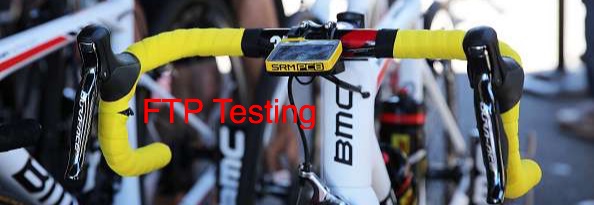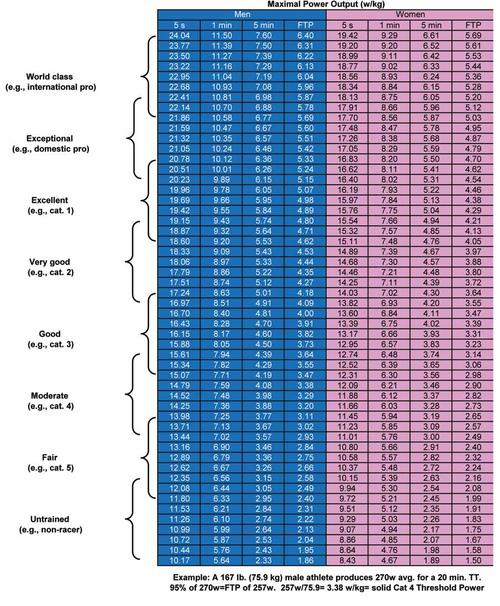An FTP test is a simple way of determining your current cycling performance level.
Knowing your own FTP enables you to track your progress, analyse your rides and set accurate pacing strategies for your key events. The term FTP stands for Functional Threshold Power and it’s a measure of the best average power output you could sustain for 1 hour in a time-trial scenario.
In this blog I’ll show you how to measure your own FTP, using easy to understand terms.
What Equipment Do You Need to Test FTP?
Essentially, you just need a bike with some kind of power meter. A power meter measures how hard and fast you pedal, giving you a figure in Watts.
There are various kinds of cycle power meters that attach to your bike and examples include SRM, Stages and Garmin.
If you don’t have one of these (they can be expensive) you might consider using a static gym bike that measures power, such as the WattBike.
Another option is to mount your own bike to an indoor trainer that measures power, such as the Tacx Bushido Smart or the CycleOps Magnus Trainer.
If your indoor trainer does not measure power, you have the option of using TrainerRoad.com, which is online software that estimates power output from the speed of the trainer’s flywheel.
All you need is some way to connect your indoor cycle trainer to a phone, tablet or computer (using Bluetooth or Ant+ connectivity).
Whichever method you choose, it’s worth remembering that the more accurate and repeatable your power meter is, the better. Bike-mounted power meters and static bikes tend to be more accurate than indoor-trainer based power measurements.
3 Ways To Test Your FTP
1. Critical Power 60 Test or CP60
This test simply involves riding as hard as you can sustain throughout a 1-hour period while measuring your average power in watts by using a power meter.
Providing you are motivated to ride as hard as you can, this is the most accurate way to determine your FTP.
However, doing a CP60 on your own can be hard mentally, due to the lack of stimulation. You might not give your best performance or you might even give up halfway through.
The best way to conduct a CP60 test is during an organised cycle time trial event, such as a 25 mile or 40km. Pinning a number on your back in a race setting will help focus your mind on delivering a great performance.
If you don’t have access to a cycle time trial, you might be better off doing a CP20 test instead (see below).
2. Critical Power 20 Test or CP20
This is simply a 20-minute time trial where you ride as hard as you can whilst measuring your average power output.
Once you know your average power for 20 minutes (for example 200 watts) you can multiply it by 95% to estimate your FTP.
So if your CP20 power output is 200 watts, a good estimation of your FTP would be 190 watts. My experience of this method suggests it’s surprisingly accurate.
Here is a short video of me testing an athlete’s CP20.
3. Use Training Peaks
If you hate tests don’t worry, there’s another way of measuring your FTP. If you upload your daily training data to online software such as TrainingPeaks.com, it will estimate your FTP power output from your best efforts in training over a given period (e.g 3 months). This is not quite as accurate as measuring it directly, but it’s not far off.
Other Things To Consider After Measuring Your FTP
In addition to testing your FTP, it’s important to measure your body weight at around the same time. This is so you can look at your FTP power output in terms of your power to weight ratio. Otherwise, any gains in your power output might be offset by gains in your body weight in a real-world setting.
You can easily work out your power to weight ratio. Divide your FTP power output by your body weight in kgs. For example, if your body weight was 70kg and your FTP is 200 watts, your FTP power to weight ratio would be 2.86 watts per kilo.
Your power to weight ratio is a particularly important metric if you’re going to be riding on hilly routes.
Whereas if you’re going to be riding flat routes, your power to drag ratio is more important. Not many people know their drag coefficient, as it requires expert testing in a wind tunnel or on a track. However, the website bestbikesplit.com does feature a way to estimate drag coefficient using your bike fitting measurements among other things.
How To Set Your Power Training Zones
Once you know your FTP, you can set your own power training zones by using various online calculators such as our own one, which is used in our training plans and by athletes training with us at myprocoach.net.
Alternatively, if you already use online software like Training Peaks or Garmin Connect they have training zone calculators you can use.
Failing that I’ve set out some guidelines about how to set your own training zones in this previous article about cycling with a power meter.













